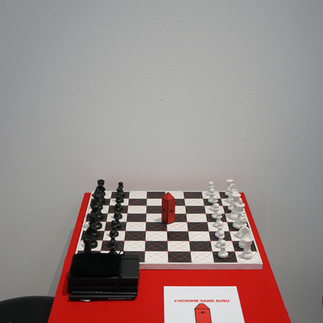l'homme sans aveu
- camillesauer
- 3 avr. 2022
- 2 min de lecture
Dernière mise à jour : 6 avr. 2024
Sculpture - 2018
Protocole: Il s'agit d'insérer un troisième joueur au sein d'une partie d'échecs. Deux joueurs d’échecs notent leur prochain coup sur un carnet gardé secret. Le troisième joueur ayant placé son nouveau pion au centre de l’échiquier, tente de deviner où le prochain joueur va frapper. S’il a vu juste, le troisième joueur fait obstruction à la partie.
L’Homme sans aveu, c’est l’histoire d’un pion qui vagabonde malgré lui de travers. Il est hors échiquier et doit se déplacer en marge du damier établi. Au sein de ce vaste échiquier, une partie d’échecs est en cours. L’homme sans aveu peut faire obstruction à cette partie en imposant le hasard par ses va-et-vient. Du hasard dans les échecs? Impossible!
Regardez d’un peu plus près... L’homme sans aveu est là, que vous le vouliez ou non. Il est le nouveau Pion. Les joueurs d’échecs se doivent donc de compter avec lui et d’anticiper ses coups, en plus des actes normalisés qu’ils effectuent sur l’échiquier. Il s’agit ainsi pour chacun des deux joueurs d’échecs de noter son prochain coup sur un carnet. Une fois le coup du joueur noté et gardé secret, l’homme sans aveu, ayant placé son nouveau pion au centre de l’échiquier, mise à son tour en se plaçant sur la case où il pense que le joueur va frapper. S’il a vu juste, l’homme sans aveu fait obstruction à la partie, dans le cas contraire, la partie continue comme si de rien n’était (ou presque). Vous l’aurez compris, plus que la logique, la capacité de l’homme sans aveu à résister au sein de l’échiquier dépend de son esprit. Ce qui est certain, c’est que l’échiquier montre pour la première fois un dysfonctionnement.



















Commentaires